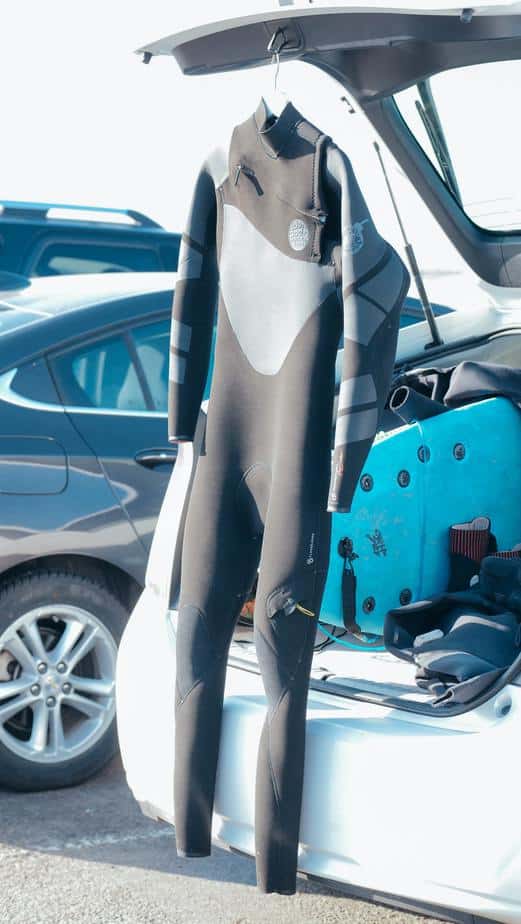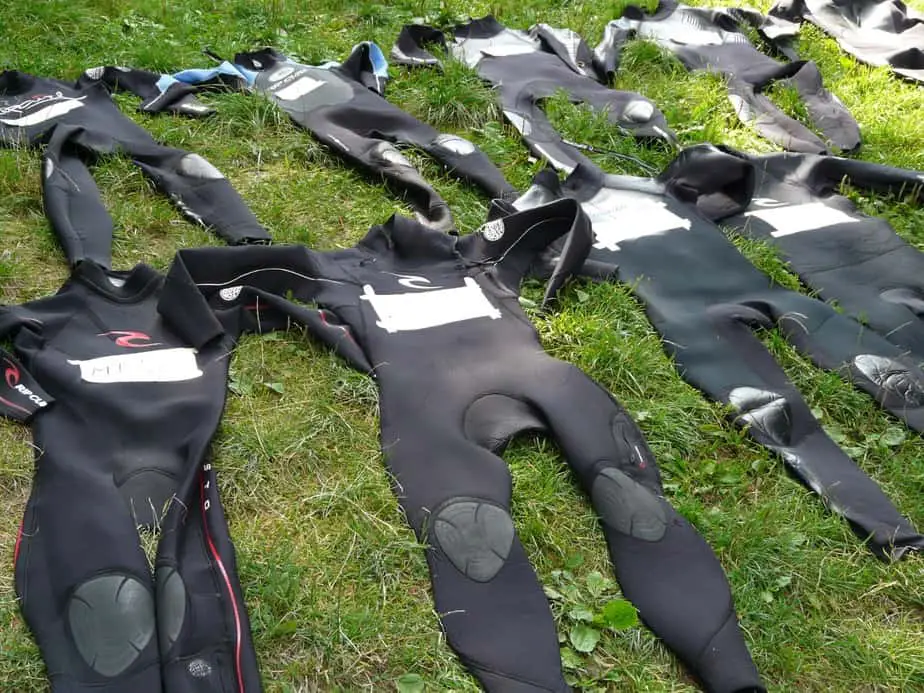If you’ve finally upgraded from renting wetsuits to having one of your own, now you have to worry about how to take care of it. That means knowing how to clean it, dry it, and store it for the offseason. As durable as the neoprene material is, you still have to know how to maintain it so it can last as long as possible.
Taking care of a wetsuit is a bit like taking care of delicate clothing. You wouldn’t toss a sensitive or expensive garment into the washing machine and then into the drying machine afterwards. That’s a surefire way to ruin your wetsuit. Instead, a wetsuit will retain its shape and durability best when you hand wash it with fresh, cold water. Afterwards, you should squeeze out the water and hang it on a padded wetsuit hanger.
Knowing how to properly maintain your wetsuit will ensure it is always prepped and ready to be worn out to the ocean or lake at a moment’s notice. Few things are worse than finding out that your wetsuit is smelly and has mildew growth on the day you plan on wearing it. A wetsuit well taken care of will last longer, ensuring you don’t have to spend money on a new suit for a while. In this article, we’ll go over the various ways you can make your wetsuit last through all of your epic adventures over the years.
What will quickly ruin a wetsuit

Nothing lasts forever; everything will undergo the effects of wear and tear. This isn’t the same as breaking-in a wetsuit, where the wetsuit starts to conform to the shape of your body. There are some factors that can drastically decrease your wetsuit’s lifespan which you should avoid.
As tough as the neoprene material is that wetsuits are made of, neglect and abuse will cause it to deteriorate at a fast pace. In this section, we’ll discuss how you can make your wetsuit last longer.
Many people make the mistake of drying their wetsuit in direct sunlight. It seems to make sense at first; the sun’s warmth will speed up the drying process so you can wear the wetsuit again in a few hours. Unfortunately, it comes with the downside of weakening the neoprene. In fact, heat in general will damage neoprene, which is also why you can’t put it in a dryer.
While you can wear a wetsuit when you’re in the water for protection from the sun’s UV rays, if you leave a wetsuit in direct sunlight for several hours, it will only serve to damage it. Instead, you should be hanging your wetsuit in a cool, shaded location that is well-ventilated.
Another common enemy of wetsuits are salt, minerals, and bacteria from the ocean that will crystallize in your wetsuit if they aren’t rinsed off. Once crystallized, they can scratch your wetsuit or cause it to be very irritating to the skin when worn. Just like any other equipment you bring with you into the water, a wetsuit must be thoroughly rinsed afterwards to prevent this. The bacteria in the water can also cause mildew growth, making your wetsuit slimy and smelly.
Improperly storing a wetsuit is another cause in its rapid deterioration. Neoprene must also be carefully stored, otherwise it can compromise its shape and structure. Scrunching it up will leave wrinkles, deformations, and possible damage if heavy equipment is placed on top of it.
Lastly, you have to be careful about what products you use to clean your wetsuit. You can make do by simply rinsing with water. However, if your wetsuit starts to get a bit smelly (from sweat, bacteria, or from peeing in it), you need to make sure you are using a wetsuit cleaner that doesn’t have harmful chemicals that can break down the neoprene. You can also consider using some homemade natural DIY cleaners.
Depending on the quality of the wetsuit, as well as how diligent you were at caring for it, a wetsuit can last as long as 4 to 10 years, possibly even more depending on how often you use it and how careful you are.
Maintaining your wetsuit in the water

As part of wetsuit care, you should also know how to take care of it when you’re actually in the water. You should always be cognizant of your surroundings, particularly of any sharp rocks, coral, or jagged surfaces that can pierce through your wetsuit and graze you.
This is unlikely to happen unless you’re breaking some rules, but aquatic life with teeth, claws, or stingers can also damage your wetsuit and hurt you. It’s for this reason that you should maintain a distance of at least a few meters from marine life, especially if it’s an endangered species. In some areas, it may actually be a mandatory rule that is punishable with severe fines if you don’t follow it.
Generally, if you just follow common sense and follow recommended practices to stay safe in the water, then your wetsuit should also be safe as well.
How to wash a wetsuit
Cleaning your wetsuit is a manual, hands-on process. Throwing the wetsuit into a washing machine is a great way to ruin it. As soon as you are out of the water, you need to rinse the wetsuit with fresh water to get rid of the sand, salt, and debris. Even if you were diving in freshwater, you need to rinse it to get rid of invasive micro-species that can attach to wet gear.
Getting rid of the saltwater prevents it from crystallizing into sharp crystals. Salt is also an irritant and can give you rashes. Salt will also degrade the performance of the wetsuit’s zip and the elasticity of the neoprene. The water must not be hot because the heat can similarly break down the neoprene.
You do not need to use a wetsuit cleaner every time, but it’s probably a good idea to clean it whenever your wetsuit starts to smell or when you can’t remember the last time you gave it a good clean. The product you use must specifically be a wetsuit shampoo because it contains neoprene-friendly ingredients. Other washing liquid or detergents have harsher chemicals not suitable for cleaning a wetsuit.
If you don’t have any wetsuit shampoo on hand, you can also go with the homemade solution/DIY route. One way is to make a mild solution with baking soda and cold water. Another method is to mix a few cups of distilled white vinegar with water and 20 drops of an essential oil of your choice.
Cleaning the wetsuit is best done in a bathtub, but a large container also works. After rinsing the wetsuit, fill the container with water and add the cleaning solution of your choice. Gently knead the wetsuit in the container until the mixture has reached all areas of the wetsuit, particularly the armpit and crotch areas. Leave it to soak in the solution for 20 to 30 minutes.
While soaking, take this time to do a thorough clean of the Velcro patches and zipper. Take a toothbrush and scrub the Velcro patches and along the zipper. Slide the zipper up and down to loosen up any dirt that might still be lodged in.
Once the suit is done soaking, it’s time to rinse the suit one last time. If you’re really a stickler for cleanliness, you can turn the suit inside out and soak it for another 20 to 30 minutes. At the very least, do a visual inspection for any stubborn dirt or debris that you might have missed if you decide soaking it once is enough.
How to dry a wetsuit

Believe it or not, if you’re not careful with how you dry your wetsuit, you can just easily ruin it even though you worked so hard to wash it. After washing your wetsuit and before hanging it up somewhere, you need to squeeze the excess water out of the wetsuit. Since wetsuits are delicate, you have to be careful about how you do this.
Do not squeeze the wetsuit the way you would squeeze a towel. Any twisting motion can damage the wetsuit. Instead, put your hands into a prayer-like pose and press the wetsuit between your hands to safely squeeze it without twisting it. You can also place your wetsuit flat between two towels and gently step on it to squeeze out the water in that area.
If you don’t squeeze out the water, the wetsuit will take a long time to dry. During this time, there is a possibility of mildew growing on the damp material. When drying it, turn it inside out so that the inside can dry first. The inside gets priority because it’s more comfortable and easier to wear a semi-dry wetsuit if the inside is completely dry and the outside is damp.
When hanging the wetsuit, hang it somewhere cool and well-ventilated away from the sun. The sun’s harsh UV rays will make the neoprene material brittle. A good location is in the bathroom. You cannot use the regular racks that you use to hang your other clothes. A wetsuit hanger is much thicker and padded, similar to a hanger used to hang a suit jacket.
A thin hanger will damage a suit because the amount of pressure the wire puts on the neoprene can cause it to deform or crease. Wetsuits can get really heavy when they are damp, so this is a no-go. When using a thick hanger, the general rule is to fold the wetsuit in half to hang. Others hang the wetsuit by the shoulders. As long as the neoprene doesn’t get creased or damaged, then do it however you like.
Repairing your wetsuit

Give it one last look over for any damage or spots you missed. It’s better for you to catch a problem now than during vacation time next year when you realize your wetsuit has a giant hole in it or something. Check the seams and check the zip condition.
Any cuts in the neoprene can be sealed up using neoprene cement. Separated seams can also be fixed with neoprene cement. If you know how to blindstitch the seam and seal it with tape and neoprene cement, even better. Stuck zips should be lubricated.
How to store your wetsuit
You’ve come so far now, you don’t want to screw this up at the final hurdle. Improperly putting your wetsuit away for long-term storage can cause it to permanently crease, roll, or fold in a way that it fails to properly conform to the shape of your body in the future. No bueno. Here’s how to do it correctly.
We’re starting to sound like a broken record here, but neoprene can easily be crushed and creased if it’s not stored properly either. This can affect the wetsuit’s insulating capabilities, so it’s best to keep it in tip-top shape. Wetsuits should be stored on a wide hanger or laid completely flat in a location away from direct sunlight. Avoid warm areas where the high temperature can degrade the neoprene’s thermal properties.
Do not place any heavy objects on the wetsuit. If space is limited, make sure the wetsuit is stored on top of everything else.
How to maintain wetsuit gloves, booties, and hoods
Wetsuit gloves, booties, and hoods, being also made of neoprene, can be washed and dried in a similar way. After a dive, rinse them to remove any dirt, minerals, and salt. Soak these wetsuit accessories in a similar solution to what you used for the wetsuit. Knead them gently, and scrub off any stubborn dirt. Turn them inside out and continue scrubbing and soaking.
To dry, first squeeze out the excess water and then place each item in separate mesh bags in a well-ventilated area away from the sun. You can also just lay these accessories flat on the floor or a table if you plan on using them the next day.
Parting words
Wetsuits are highly versatile pieces of gear used in many water sports, and if you take good care of them, then they can last a long time. In the same way that renting a wetsuit can begin to cost a lot if you do it frequently, there’s no need to replace a perfectly good wetsuit each year if you know how to take good care of it.
Whether you’re snorkeling, surfing, or scuba diving, a wetsuit is an important piece of gear that you need to protect, and in turn, they’ll protect you back!


